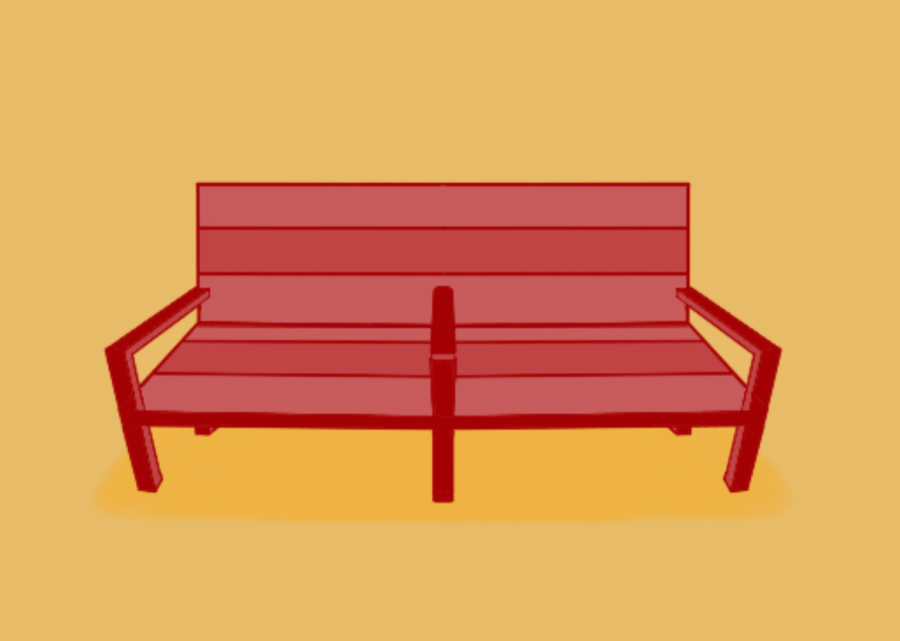Opinion | Anti-homeless architecture is dangerous
November 3, 2021
The term “hostile architecture” — also known as “anti-homeless architecture” or “defensive design” — refers to city planners purposely building infrastructure that deters homeless people from “setting up camp” in public spaces. Defensive design architects claim these elements are intended to eliminate crime and ensure that public spaces are used for their original purposes, but this is really just code for excluding specific, unwanted groups.
Anti-homeless architecture manifests in a variety of structures. Some common ones are benches with dividers, spiked window sills, slanted benches and under-bridge spikes. Have you ever sat on a public bench and wondered why there was a divider between you and the person beside you? Have you ever been waiting for a bus and leaned behind you, only to find a spiked ledge?
Hostile architecture appears as something that’s useful for citizens. Planters on the sidewalk will appear as green foliage, when in reality, they are structures to redirect people out of sheltered areas. Sidewalk boulders will seem like abstract architectural art, when they are really built to deter the homeless population. Curved benches will seem like a funky design choice, when their true purpose is to prevent homeless people from sleeping on them. The way I see it, the goal of hostile architecture is to be discreet and confusing in order to mask its true purpose. That’s why these elements are so subtle.
Planners almost always know that there are alternative purposes for these architectural elements. For example, advocates of defensive design argue that their tactics discourage criminal activity, and that the perception of safety is nearly as important as any changes in crime rates that actually happen in reality. Pushing homeless people to the public periphery enables the rest of the city to turn a blind eye.
These tactics also create an association between homelessness and crime rates in cities. Those associations do not help homeless people who already suffer from the harsh conditions of the physical environment, let alone harsh social prejudice. The last thing cities need to do is further stigmatize an already stigmatized population.
Based on my experience as an urban studies student, and more broadly, my experience walking around Pittsburgh, I firmly believe that hostile architecture is an urgent issue — one that needs to be solved sooner rather than later. Beyond that, I just don’t believe we should design to exclude. The purpose of communal spaces such as parks and public infrastructure like benches is to extend community, not limit it.
Had I never learned why dividers exist on benches, or bricks exist alongside sidewalk gardens, I would’ve continued to naively walk alongside these structures of suffering. A bench with dividers to somebody who is not homeless is merely a bench. A boulder under a bridge is exactly that — a boulder under a bridge. But to somebody who is housing insecure, that bench means a place to sleep. To a homeless person, a bridge means shelter. It means protection from heavy rain and snow, as well as a place with privacy.
But have these private planners ever asked the homeless population what helps them?
If we do not deconstruct anti-homeless architecture — and advocate for inclusive architecture — not only will homeless populations continue to be ostracized and stigmatized, but we will continue to be bystanders to infrastructure that can kill.This may seem austere or dramatic, but the logic is really simple. Take for instance fenced grates, which defensive design architects purposely cut off to prevent homeless people from staying warm. If a homeless person dies from hypothermia, and could have stayed warm from one of those grates, how in any way is that not murder? If a grate can protect somebody from getting hypothermia in below-freezing temperatures, fencing off that grate is unconscionable.
Architects are intentionally making homelessness — which is already incredibly difficult — even harder.
The issue of hostile architecture is not something we can put on the back burner and naively pretend doesn’t exist. Not only are the consequences of defensive design severe, but the actual purpose of defensive design does not in any way solve the nation’s or Allegheny County’s homeless crisis.
Rather, it creates an “out of sight, out of mind” narrative for non-homeless citizens, while homeless individuals’ housing insecurity just becomes worse. Not only that, but it reveals that there is an elite group of people who get to manipulate our city spaces — and our very behavior in those spaces. Architects literally decide who is allowed in which public spaces.
Architects and city planners aren’t stupid — they know the harm caused by defensive design. Not only is Allegheny County’s homeless population rapidly increasing, but shelters in the region are struggling to find the space and funding to accommodate these people.
Hostile architecture is not just a form of exclusion, but a form of behavioral manipulation. Through defensively constructing our cities, planners are deciding who can walk where, whether or not someone is able to sleep there and — most frightening of all — literally pushing homeless people out of the public eye.
Given that studies have shown there are ample other ways to deter community crime, defensive design only seems to exist to punish homeless people. Researchers found in a 2018 study that green spaces and community gardens in previously vacant lots reduced violent crime by 30%, reduced people’s fear of going outside due to safety concerns by 58% and increased people’s use of outside space by 76%. We clearly know how to increase public safety without harming the most vulnerable among us.
Hostile architecture is literally and metaphorically designed to be hidden right in front of us. If we do not push back on proponents of hostile architecture, the homelessness epidemic will only worsen.
Andrea Pauliuc writes primarily about urban issues, community empowerment and politics. Write to her at [email protected].








